Unsupervised Learning and Text Mining of Emotion Terms Using R
Unsupervised learning refers to data science approaches that involve learning without a prior knowledge about the classification of sample data. In Wikipedia, unsupervised learning has been described as “the task of inferring a function to describe hidden structure from ‘unlabeled’ data (a classification of categorization is not included in the observations)”. The overarching objectives of this post were to evaluate and understand the co-occurrence and/or co-expression of emotion words in individual letters, and if there were any differential expression profiles /patterns of emotions words among the 40 annual shareholder letters? Differential expression of emotion words was being used to refer to quantitative differences in emotion word frequency counts among letters, as well as qualitative differences in certain emotion words occurring uniquely in some letters but not present in others.
The dataset
This is the second part to a companion post I have on “parsing textual data for emotion terms”. As with the first post, the raw text data set for this analysis was using Mr. Warren Buffett’s annual shareholder letters in the past 40-years (1977 – 2016). The R code to retrieve the letters was from here.
## Retrieve the letters
library(pdftools)
library(rvest)
library(XML)
# Getting & Reading in HTML Letters
urls_77_97 <- paste('http://www.berkshirehathaway.com/letters/', seq(1977, 1997), '.html', sep='')
html_urls <- c(urls_77_97,
'http://www.berkshirehathaway.com/letters/1998htm.html',
'http://www.berkshirehathaway.com/letters/1999htm.html',
'http://www.berkshirehathaway.com/2000ar/2000letter.html',
'http://www.berkshirehathaway.com/2001ar/2001letter.html') letters_html <- lapply(html_urls, function(x) read_html(x) %>% html_text())
# Getting & Reading in PDF Letters
urls_03_16 <- paste('http://www.berkshirehathaway.com/letters/', seq(2003, 2016), 'ltr.pdf', sep = '')
pdf_urls <- data.frame('year' = seq(2002, 2016),
'link' = c('http://www.berkshirehathaway.com/letters/2002pdf.pdf', urls_03_16))
download_pdfs <- function(x) {
myfile = paste0(x['year'], '.pdf')
download.file(url = x['link'], destfile = myfile, mode = 'wb')
return(myfile)
}
pdfs <- apply(pdf_urls, 1, download_pdfs)
letters_pdf <- lapply(pdfs, function(x) pdf_text(x) %>% paste(collapse=" "))
tmp <- lapply(pdfs, function(x) if(file.exists(x)) file.remove(x))
# Combine letters in a data frame
letters <- do.call(rbind, Map(data.frame, year=seq(1977, 2016), text=c(letters_html, letters_pdf)))
letters$text <- as.character(letters$text)
Analysis of emotions terms usage
## Load additional required packages
require(tidyverse)
require(tidytext)
require(gplots)
require(SnowballC)
require(sqldf)
theme_set(theme_bw(12))
### pull emotion words and aggregate by year and emotion terms emotions <- letters %>%
unnest_tokens(word, text) %>%
anti_join(stop_words, by = "word") %>%
filter(!grepl('[0-9]', word)) %>%
left_join(get_sentiments("nrc"), by = "word") %>%
filter(!(sentiment == "negative" | sentiment == "positive")) %>%
group_by(year, sentiment) %>%
summarize( freq = n()) %>%
mutate(percent=round(freq/sum(freq)*100)) %>%
select(-freq) %>%
spread(sentiment, percent, fill=0) %>%
ungroup()
## Normalize data
sd_scale <- function(x) {
(x - mean(x))/sd(x)
}
emotions[,c(2:9)] <- apply(emotions[,c(2:9)], 2, sd_scale)
emotions <- as.data.frame(emotions)
rownames(emotions) <- emotions[,1]
emotions3 <- emotions[,-1]
emotions3 <- as.matrix(emotions3)
## Using a heatmap and clustering to visualize and profile emotion terms expression data heatmap.2(
emotions3,
dendrogram = "both",
scale = "none",
trace = "none",
key = TRUE,
col = colorRampPalette(c("green", "yellow", "red"))
)
Heatmap and clustering: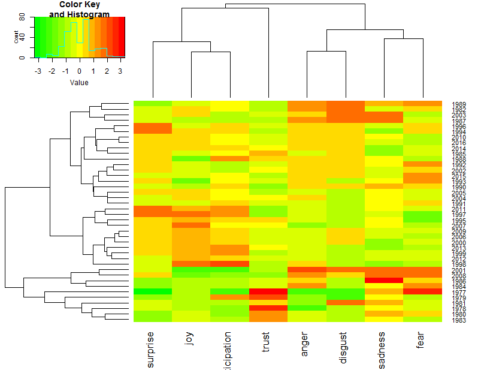
The colors of the heatmap represent high levels of emotion terms expression (red), low levels of emotion terms expression (green) and average or moderate levels of emotion terms expression (yellow).
Co-expression profiles of emotion words usage
Based on the expression profiles combined with the vertical dendrogram, there are about four co-expression profiles of emotion terms: i) emotion terms referring to fear and sadness appeared to be co-expressed together, ii) anger and disgust showed similar expression profiles and hence were co-expressed emotion terms; iii) emotion terms referring to joy, anticipation and surprise appeared to be similarly expressed, and iv) emotion terms referring to trust did show the least co-expression pattern.
Emotion expression profiling of annual shareholder letters
Looking at the horizontal dendrogram and heatmap above, approximately six groups of emotions expressions profiles can be recognized among the 40 annual shareholder letters.
Group-1 letters showed over-expression of emotion terms referring to anger, disgust, sadness or fear. Letters of this group included 1982, 1987, 1989 & 2003 (first 4 rows of the heatmap).
Group-2 and group-3 letters showed over-expression of emotion terms referring to surprise, disgust, anger and sadness. Letters of this group included 1985, 1994, 1996, 1998, 2010, 2014, 2016, 1990 – 1993, 2002, 2004, 2005 & 2015 (rows 5 – 19 of the heatmap).
Group-4 letters showed over-expression of emotion terms referring to surprise, joy and anticipation. Letters of this group included 1995, 1997 – 2000, 2006, 2007, 2009 & 2011 – 2013 (rows 20 – 30).
Group-5 letters showed over-expression of emotion terms referring to fear, sadness, anger and disgust. Letters of this group included 1984, 1986, 2001 & 2008 (rows 31 – 34).
Group-6 letters showed over-expression of emotion terms referring to trust. Letters of this group included those of the early letters (1977 – 1981 & 1983) (rows 35 – 40).
Numbers of emotion terms expressed uniquely or in common among the heatmap groups
The next steps of the analysis attempted to determine the numbers of emotion words that were uniquely expressed in any of the heatmap groups. Also wanted to see if some emotion words were expressed in all of the heatmap groups, if any? For these analyses, I chose to include a word stemming procedure. Wikipedia described word stemming as “the process of reducing inflected (or sometimes derived) words to their word stem, base or root form- generally a written word form”. In practice, the stemming step removes word endings such as “es”, “ed” and “’s”, so that the various word forms would be taken as same when considering uniqueness and/or counting word frequency (see the example below for before and after applying word stemmer function in R).
Examples of word stemmer output
There are several word stemmers in R. One such function, the wordStem, in the SnowballC package extracts the stems of each of the given words in a vector (See example below).
Before <- c("produce", "produces", "produced", "producing", "product", "products", "production")
wstem <- as.data.frame(wordStem(Before))
names(wstem) <- "After"
pander::pandoc.table(cbind(Before, wstem))
Here is the example output for stemming
## ------------------
## Before After
## ---------- -------
## produce produc
##
## produces produc
##
## produced produc
##
## producing produc
##
## product product
##
## products product
##
## production product
## ------------------
Analysis of unique and commonly expressed emotion words
## pull emotions words for selected heatmap groups and apply stemming
set.seed(456)
emotions_final <- letters %>%
unnest_tokens(word, text) %>%
filter(!grepl('[0-9]', word)) %>%
left_join(get_sentiments("nrc"), by = "word") %>%
filter(!(sentiment == "negative" | sentiment == "positive" | sentiment == "NA")) %>%
subset(year==1987 | year==1989 | year==2001 | year==2008 | year==2012 | year==2013) %>%
mutate(word = wordStem(word)) %>%
ungroup()
group1 <- emotions_final %>%
subset(year==1987| year==1989 ) %>%
select(-year, -sentiment) %>%
unique()
set.seed(456)
group4 <- emotions_final %>%
subset(year==2012 | year==2013) %>%
select(-year, -sentiment) %>%
unique()
set.seed(456)
group5 <- emotions_final %>%
subset(year==2001 | year==2008 ) %>%
select(-year, -sentiment) %>%
unique()
Unique and common emotion words among two groups
Let’s draw a two-way Venn diagram to find out which emotions terms were unique or commonly expressed between heatmap group-1 & group-4.
# common and unique words between two groups
emo_venn2 <- venn(list(group1$word, group4$word))
Two-way Venn diagram: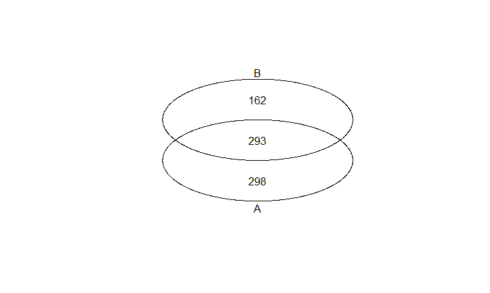
A total of 293 emotion terms were expressed in common between group-1 (A) and group-4 (B). There were also 298 and 162 unique emotion words usage in heatmap groups-1 & 4, respectively.
Unique and common emotion words among three groups
Let’s draw a three way Venn diagram to find out which emotions terms were uniquely or commonly expressed among group-1, group-4 & group-5.
# common and unique words among three groups
emo_venn3 <- venn(list(group1$word, group4$word, group5$word))
Three way Venn diagram: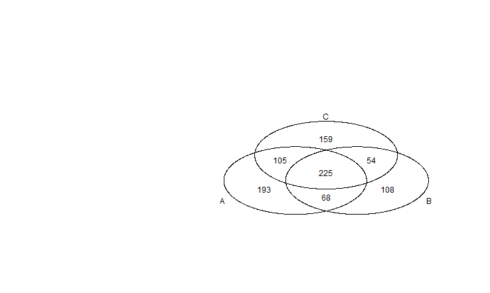
A total of 225 emotion terms were expressed in common among the three heatmap groups. On the other hand, there were 193, 108 and 159 unique emotion words usage in heatmap group-1 (A), group-4 (B) and group-5 (C), respectively. The Venn diagram included various combinations of unique and common emotion word expressions. Of particular interest were the 105 emotion words that were expressed in common between heatmap group-1 and group-5. Recall that group-1 & group-5 were highlighted for their high expression of emotions referring to disgust, anger, sadness and fear.
I also wanted to see a list of those emotion words that were expressed uniquely and/or in common among several groups. For instance the R code below requested for a list of the 109 unique emotion words that were expressed solely in group-5 letters of the 2001 & 2008.
## The code below pulled a list of all common/unique emotion words expressed
## in all possible combinations of the the three heatmap groups
venn_list <- (attr(emo_venn3, "intersection"))
## and then print only the list of unique emotion words expressed in group-5.
print(venn_list$'C')
## [1] "manual" "familiar" "sentenc"
## [4] "variabl" "safeguard" "abu"
## [7] "egregi" "gorgeou" "hesit"
## [10] "strive" "loyalti" "loom"
## [13] "approv" "like" "winner"
## [16] "entertain" "tender" "withdraw"
## [19] "harm" "strike" "straightforward"
## [22] "victim" "iron" "bounti"
## [25] "chaotic" "bloat" "proviso"
## [28] "frank" "honor" "child"
## [31] "lemon" "prospect" "relev"
## [34] "threaten" "terror" "quak"
## [37] "scarciti" "question" "manipul"
## [40] "deton" "terrorist" "attack"
## [43] "ill" "nation" "hydra"
## [46] "disast" "sadli" "prolong"
## [49] "concern" "urgenc" "presid"
The output from the above code included a list of 159 words, but the list above contained only the first 51 for space considerations. Besides, you may have noticed that some of the emotions words were truncated and did not look proper words due to stemming.
Dispersion Plot
Dispersion plot is a graphical display that can be used to represent the approximate locations and densities of emotion terms across the length of the text document. Shown below are three dispersion plots of unique emotion words of heatmap group-1 (1987, 1989), group-5 (2001, 2008) and group-4 (2012 and 2013) shareholder letters. For the dispersion plots, all words in the listed years were sequentially ordered by year of the letters and the presence and approximate locations of the unique words were identified/displayed by a stripe. Each stripe represented an instance of a unique word in the shareholder letters.
Confirmation of emotion words expressed uniquely in heatmap group-1
## Confirmation of unique emotion words in heatmap group-1
group1_U <- as.data.frame(venn_list$'A')
names(group1_U) <- "terms"
uniq1 <- sqldf( "select t1.*, g1.terms
from emotions_final t1
left join
group1_U g1
on t1.word = g1.terms "
)
uniq1a <- !is.na(uniq1$terms)
uniqs1 <- rep(NA, length(emotions_final))
uniqs1[uniq1a] <- 1
plot(uniqs1, main="Dispersion plot of emotions words \n unique to heatmap group 1 ", xlab="Length (Word count)", ylab=" ", col="red", type='h', ylim=c(0,1), yaxt='n')
Heatmap plot: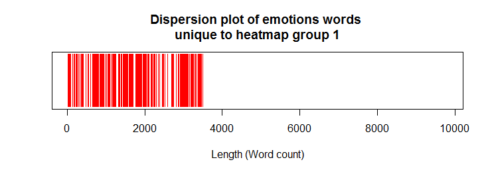
Heatmap group-1 letters included those in 1987/1989. As expected, the dispersion plot above confirmed that the unique emotion words in group-1 were confined at the start of the dispersion plot.
Confirmation of emotion words expressed uniquely in heatmap group-5
## confirmation of unique emotion words in heatmap group-5
group5_U <- as.data.frame(venn_list$'C')
names(group5_U) <- "terms"
uniq5 <- sqldf( "select t1.*, g5.terms
from emotions_final t1
left join
group5_U g5
on t1.word = g5.terms "
)
uniq5a <- !is.na(uniq5$terms)
uniqs5 <- rep(NA, length(emotions_final))
uniqs5[uniq5a] <- 1 plot(uniqs5, main="Dispersion plot of emotions words \n unique to heatmap group 5 ", xlab="Length (Word count)", ylab=" ", col="red", type='h', ylim=c(0,1), yaxt='n')
Dispersion plot of emotions words: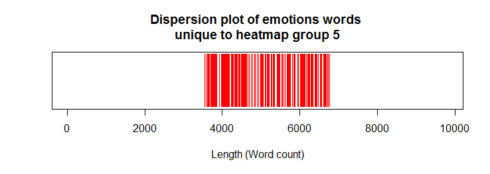
Heatmap group-5 letters included those in 2001 & 2008. As expected, the dispersion plot above confirmed that the unique emotion words in group-5 were confined at the middle parts of the dispersion plot.
Confirmation of emotion words expressed uniquely in heatmap group-4
## confirmation of unique emotion words in heatmap group-4
group4_U <- as.data.frame(venn_list$'B')
names(group4_U) <- "terms"
uniq4 <- sqldf( "select t1.*, g4.terms
from emotions_final t1
left join
group4_U g4
on t1.word = g4.terms "
)
uniq4a <- !is.na(uniq4$terms)
uniqs4 <- rep(NA, length(emotions_final))
uniqs4[uniq4a] <- 1 plot(uniqs4, main="Dispersion plot of emotions words \n unique to heatmap group 4 ", xlab="Length (Word count)", ylab=" ", col="red", type='h', ylim=c(0,1), yaxt='n')
Dispersion plot of emotions words: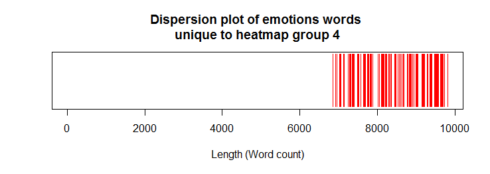
Heatmap group4 letters included those in 2012 & 2013. As expected, the dispersion plot above confirmed that the unique emotion words in group-4 were confined towards the end of the dispersion plot.
Annual Returns on Investment in S&P500 (1977 – 2016)
Finally a graph of the annual returns on investment in S&P 500 during the same 40 years of the annual shareholder letters is being displayed below for perspective. The S&P 500 data was downloaded from here using an R code from here.
## You need to first download the raw data before running the code to recreate the graph below.
ggplot(sp500[50:89,], aes(x=year, y=return, colour=return>0)) +
geom_segment(aes(x=year, xend=year, y=0, yend=return),
size=1.1, alpha=0.8) +
geom_point(size=1.0) +
xlab("Investment Year") +
ylab("S&P500 Annual Returns") +
labs(title="Annual Returns on Investment in S&P500", subtitle= "source: http://pages.stern.nyu.edu/~adamodar/New_Home_Page/datafile/histretSP.html") +
theme(legend.position="none") +
coord_flip()
Annual Returns on Investment in S&P500: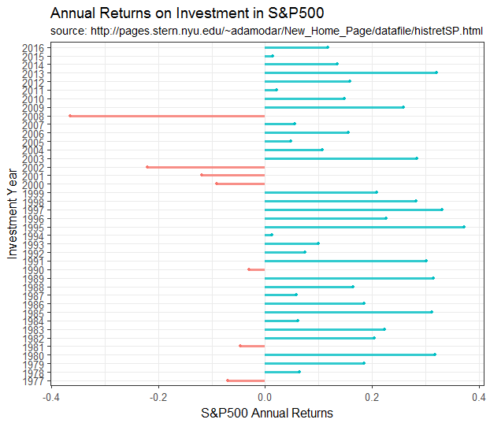
Concluding Remarks
R offers several packages and functions for the evaluation and analyses of differential expression and co-expression profiling of emotion words in textual data, as well as visualization and presentation of analyses results. Some of those functions, techniques and tools have been attempted in two companion posts. Hopefully, you found the examples helpful.
转自:https://datascienceplus.com/unsupervised-learning-and-text-mining-of-emotion-terms-using-r/
Unsupervised Learning and Text Mining of Emotion Terms Using R的更多相关文章
- (Deep) Neural Networks (Deep Learning) , NLP and Text Mining
(Deep) Neural Networks (Deep Learning) , NLP and Text Mining 最近翻了一下关于Deep Learning 或者 普通的Neural Netw ...
- Machine Learning and Data Mining(机器学习与数据挖掘)
Problems[show] Classification Clustering Regression Anomaly detection Association rules Reinforcemen ...
- Machine Learning Algorithms Study Notes(4)—无监督学习(unsupervised learning)
1 Unsupervised Learning 1.1 k-means clustering algorithm 1.1.1 算法思想 1.1.2 k-means的不足之处 1 ...
- Machine Learning and Data Mining Lecture 1
Machine Learning and Data Mining Lecture 1 1. The learning problem - Outline 1.1 Example of mach ...
- An Introduction to Text Mining using Twitter Streaming
Text mining is the application of natural language processing techniques and analytical methods to t ...
- 正则表达式和文本挖掘(Text Mining)
在进行文本挖掘时,TSQL中的通配符(Wildchar)显得功能不足,这时,使用“CLR+正则表达式”是非常不错的选择,正则表达式看似非常复杂,但,万变不离其宗,熟练掌握正则表达式的元数据,就能熟练和 ...
- coursera 公开课 文本挖掘和分析(text mining and analytics) week 1 笔记
一.课程简介: text mining and analytics 是一门在coursera上的公开课,由美国伊利诺伊大学香槟分校(UIUC)计算机系教授 chengxiang zhai 讲授,公开课 ...
- Unsupervised Learning: Use Cases
Unsupervised Learning: Use Cases Contents Visualization K-Means Clustering Transfer Learning K-Neare ...
- Supervised Learning and Unsupervised Learning
Supervised Learning In supervised learning, we are given a data set and already know what our correc ...
随机推荐
- quartus ii有符号数的问题(待完善)
1.有符号数是以补码的形式存储的,在modelsim仿真时,补码自动转换为有符号的十进制数. 2.关于截位的问题: 当只取寄存器中的其中m位时,这时候取得的数是按照无符号位来处理的? 3.reg型数据 ...
- 国付宝ecshop,shopex,shopnc在线支付接口,php版本支付接口开发
最近应一个客户的要求,给他的一个ecshop商城开发国付宝在线支付接口.国付宝估计大家比较陌生,但是他集成了很多银行的一些网银接口,所以比较方便.号称国家级的第三方支付平台.最近有增加了域名验证,就是 ...
- 苹果新手MacBook 目录认识
最近,开发平台从windows转型到mac. 刚开始还真不适应 不过使用了几天之后 还是很不错的. 那么我们来认识一下目录,用过linux的应该很好适应unix的mac MAC是Unix系统 和Win ...
- sql解析xml
我们有时候需要在sql中解析xml,xml解析sql实例如下: DECLARE @params xml DECLARE @customparams xml = null -- 0.解析输入参数 ...
- 【C和指针】笔记1
数据 基本数据类型 整型家族:包含字符,短整型,整型和长整型 整型相互之间大小规定如下: 长整型至少和整型一样长,而整型至少应该和短整型一样长. short int至少16位,long int至少32 ...
- 推送一个已有的代码到新的 gerrit 服务器
1.指定项目代码库中迭代列出全部ProductList(.git)到pro.log文件中 repo forall -c 'echo $REPO_PROJECT' | tee pro.log pro.l ...
- sed命令详解-应用篇
本篇从实用的角度讲解sed,关于sed的详细帮助文档,请参考前篇 http://www.cnblogs.com/the-capricornus/p/5279979.html 本篇用到的选项请参考前篇. ...
- 【DP系列学习一】简单题:kickstart2017 B.vote
https://code.google.com/codejam/contest/6304486/dashboard#s=p1 这是一道简单的dp,dp[i][j]代表A的voter为i,B的voter ...
- fileInput实战总结
fileinput组件实战总结 fileinput是一个增强的基于Bootstrap3.x和HTML5的文件上传工具,具备多种格式文件的预览功能, 另外,它包含了基于AJAX的上传,拖拽和撤销文件,可 ...
- String转int数字格式异常问题
写在前面的话 差不多一年前就计划写博客,可因为种种原因一直没有写,反而我身边的一些同学在我建议他们写博客不久之后就写了,比如张博同学,基本每次总结一个知识点就写一篇,这样不但方便自己以后查看翻阅,也 ...
